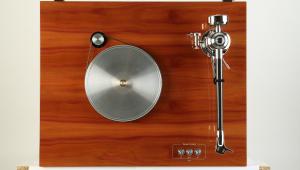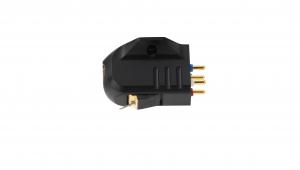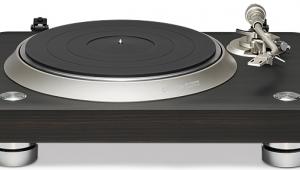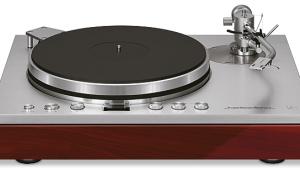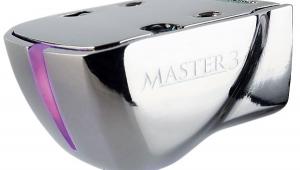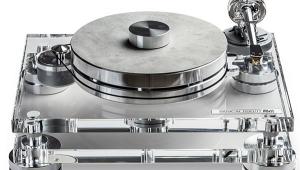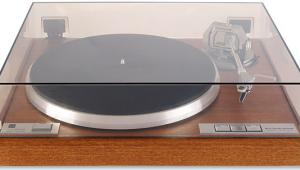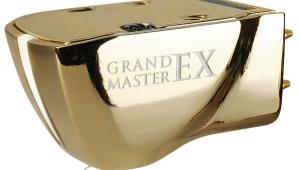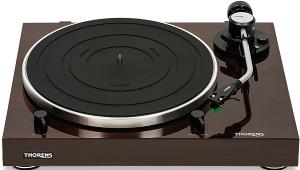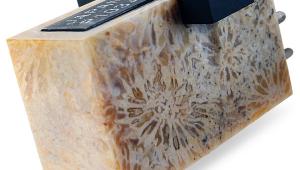Eat E Flat (£4100)

The wife of Pro-Ject’s CEO Heinz Lichtenegger, Jozefina, is one of the gutsiest individuals in hi-fi today. Not only does she insist that the turntables under her EAT Forté banner are high-end, while hubby’s Pro-Ject concentrates on the affordable, she’s had the sheer guts to revive a much reviled form. Flat tonearms are as old as hi-fi itself, the E-Flat’s arm following Connoisseur’s CS1, the wooden Grace G-714, an early Grado, the back half of the ‘hinged’ Dynavector DV-507 and many others. Jozefina and the team at Pro-ject have re-opened the flat arm’s coffin.
E-Flat’s interpretation, though, owes more to the ultra-flat arm of the NAD 5120 turntable, launched in late 1983, than to the above ‘flat-sos’ of the 1950s-1970s. The main difference is the material. The E-Flat uses Kevlar, aramids and other carbon-fibre types that had found their way into myriad arms going back to Infinity’s Black Widow of the 1970s. The E-Flat arm, though, is a slab rather than a tube.
KEVLAR AND UNIPIVOT DESIGN
It’s worth dismissing any flashbacks – if you’re old enough to remember 1983 – to the fracas that ensued when NAD introduced its flat arm. The use of Kevlar can change the rules, as any who have tried to bend a Wilson Benesch arm tube will tell you.
Equally, thanks to full access to Pro-ject’s 20-years-plus of experience, the E-Flat is the product of a mature manufacturer despite EAT’s comparative youth of around a decade. The anticipated virtues of the arm should be attributable to, in EAT’s words: ‘no hollow tube to suffer the inevitable echo effects or ringing; greater stiffness… the E-Flat tonearm’s performance is truly quiet and incredibly fast.’
Another example of Jozefina’s gutsiness is opting for a unipivot, which remains a contentious bearing type. I would venture to say that amongst hard-core analogue-ists, it’s as divisive a topic as valves versus transistors are for amplifier purists. But those who love such classics as the various Deccas and Ultracrafts will need no convincing of the merits of unipivots. The flatness, well, that’s another story entirely.
It’s not just the unusual tonearm, though, that distinguishes the E-Flat from the Forté and Forté S. Arm notwithstanding, this turntable is very much of the Forté family. It possesses an over-sized, 33cm, critically damped platter, a highly-polished rectangular wooden plinth, soft-touch controls, damped feet, plenty of Sorbothane damping in critical areas and a massive record clamp, like its dearer siblings. Crucial to the family gene pool is the signature combination of two motors with, on this occasion, one belt.
Where the E-Flat changes direction is in hiding them under the platter. With the flagship Forté, the motors reside in an outboard chassis. The less costly Forté S uses a single-piece plinth, but the pulleys and belts are still exposed. By positioning them under the platter, the E-Flat looks cleaner – both more modern and yet resolutely retro. It could pass for a mid-1970s Denon or Micro-Seiki direct-drive.
EAT describes the new arm as ‘Ultra-flat, ultra-light and ultra-rigid’ – all desirable qualities if realised [see Lab Report, p28]. It measures 10in, and is supported by the aforementioned unipivot bearing, terminating with a fully adjustable counterweight decoupled by Sorbothane. The unipivot system is produced from components with ‘especially hard metal surfaces’, while any fear of instability or unwanted motion should be assuaged by the high mass of the unipivot housing and the presence of two metal guides.
INTERCHANGE FACILITY
Cartridge fanatics – those who keep a multitude for various record labels, genres or original cutting head types – will appreciate that the carbon-fibre arm can be changed by the user to suit specific requirements, with lighter or heavier versions available to ensure the correct setting of different arm/cartridge resonant frequencies.
Another benefit is that the arm’s flatness and shallow side-view make levelling it a breeze. The arm also features easy-to-adjust anti-skating, and its cueing lever is nicely damped.
Although offered with a dedicated moving-coil cartridge for another £1000, we looked at the E-Flat strictly as an arm/turntable combination. I tried it with Koetsu and Air-Tight MCs, feeding the Audio Research PH5 phono stage, REF5 preamplifier and Quad II-eighty monoblocks, driving Wilson Audio Sophia 3s. All wiring was YTER.
Having played with and/or heard so many Fortés over the past two years, I had no doubt that the deck itself would be the least ‘new’ of the elements to assess. I already knew, for example, that the single-chassis Forté S had successfully maintained a good 95% of the double-chassis Forté’s performance. Merely positioning the belt, pulleys and motors under the platter would hardly upset the trickle-down path. The main challenge would be the arm’s effect.
It must be stated here – and I hope that other reviewers will be as forthcoming about their own biases – that I have no issues with unipivots. My standard remains the SME Series V, but I have lived with so many unipivots that it would be deceitful not to state one’s position. So, I have, in this case, no axe to grind, etc.
SWEET TREBLE
Aside from the initially daunting set-up of an arm/turntable that arrives in pieces, I was deeply relieved to hear nothing that could undermine Mrs Lichtenegger’s confidence in her new tonearm. No ringing, microphony or smearing assailed my ears. If anything, I was hearing a sweet treble that gave up only the tiniest traces of hyper-detail in its path to luscious, liquid highs. A bout with a few early Byrds LPs, all jangly Rickenbacker and those Crosby/Clark/McGuinn harmonies sealed it.
By starting with ‘The Bells Of Rhymney’ the bar was raised so high that it could only go downhill from there – or so I thought. It’s classic, undiluted Byrds, opening with the aforementioned jangly chords, supported by Gene Clark’s tambourine and McGuinn-led harmonies from the opening bars. The E-Flat traced every groove to perfection, not a hint of sibilance marring the performance. Equally delicious was the crisp, staccato drumming from Michael Clarke, one of rock’s more under-rated wizards. Though slightly buried in the mix of ‘All I Really Want To Do’, it lends support if in an almost invisible manner. You don’t focus on it. It’s simply there.
The EAT kept it in perfect proportion, at the same time allowing the voices to mesh with the weave of 300-thread Egyptian cotton sheets, and the guitars to soar with a clarity that defies any accusations one might level at a flat arm if conditioned to think it must resonate. I was revelling in the barrelhouse/honky-tonk piano and bottleneck guitar on the later Byrds’ ‘You’re Still On My Mind’, when it occurred to me that I needed to hear something ‘bigger’, silkier. And what better than the fashionable-again Doris Day? Easily one of the greatest warblers ever to cover a standard, her lush take of ‘Let’s Face The Music And Dance’ provided an orchestra in a deliciously restrained mood. The voice has texture and breathiness so subtle that any inferior system can mask them. Not so through the E-Flat. Ms Day was so close you could imagine the warmth of… well, let’s show our own form of restraint here.
Muted brass, a delicate piano stage left – one cannot avoid the term ‘silky’. And the rhythmic flow! A slight change in tempo 2m 15s into this masterpiece catches you unaware, the shift handled with aplomb. And it worked in mono, with the hoary old advertiser’s fave, Bobby Darin’s ‘Beside The Sea’, showing a depth and solidity that makes you forget/forgive its single-channel status. The crashing, smashing drum attacks from 1m 29s onward reveal a punch, power and force that will jolt you from any reverie the first minute created.
Drum lust led me to Warren Zevon’s ‘Werewolves Of London’ (though it’s hard not to picture Tom Cruise and his Color Of Money pool cue acrobatics when hearing this song). The opening, courtesy of Mick Fleetwood and John McVie, let the diminutive Sophia 3s strut their stuff, coming off like the audio equivalent of James Cagney – a bantam that performs way above its weight, the clamour of the keyboards, the solid rhythm section coalescing into a glorious whole, yet acting as a platform for Zevon’s sly vocals.
ANOTHER KIND OF POOL
And so it went, LP to LP, Joe Walsh’s ‘Life’s Been Good’ churning with a force that elicits the most embarrassing of air-guitar moves. His voice, fed through whatever oddball processing was used back in 1978, is recognised for the weary, jaded rock-star bleat that suits the lyrical content. Underscoring it is a quasi-reggae beat, flashes of electricity tangling with synthetic notes so rich in their artifice that it’s as if ‘unplugged’ never arrived two decades later.
Aah, those bottom octaves! God bless oversized platters, big, fat feet and whatever stew comprises Sorbothane. Rich, dark, liquid, with plenty of mass – you felt as if you were listening from the bottom of the swimming pool immortalised on the sleeve. The exponential decay of the notes, the sizzle of the cymbals, the tinkle of the piano combined to paint a sonic picture worthy of Walsh’s storytelling skills.
A different emotion motivated Lynyrd Skynyrd’s ‘Sweet Home Alabama’, as (regionally) patriotic a song as rock ever yielded, showing what this much-mourned Southern band felt about their home state. Somehow, I can’t imagine a song like ‘Sweet Home Huddersfield’ or somesuch delivering the same majesty… The power of the percussive attacks, the massed vocals, the relentless guitar assault possessed every element of sheer energy needed to convey what is as anthemic a song as one could want to hear – if an Alabamian.
VERDICT
Guilty admission: I was not expecting to fall in love with the E-Flat, even though I find its siblings so enjoyable. The arm concerned me, but I was proven wrong: this deck is magnificent, representing far better value than something selling for £4100 deserves to do. The sound, the looks, the build quality and finish – the only thing I can fault is the thin Styrofoam packing! With its E-Flat, EAT has truly come of age.
Originally published in the January 2012 issue






